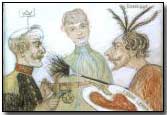Primary Documents - Extract from General Leman's Diary, August 1914
 During 5-16 August 1914 the
first land battle of World War One saw the German Second Army's attempts to
demolish and then capture the vital Belgian fortress city of
Liege.
Click here
for details of the battle that ran during those dates, and the reasons for
its significance.
During 5-16 August 1914 the
first land battle of World War One saw the German Second Army's attempts to
demolish and then capture the vital Belgian fortress city of
Liege.
Click here
for details of the battle that ran during those dates, and the reasons for
its significance.
With the fall of Liege its Belgian commander, General Gerard Leman, was carried wounded and unconscious out of the forts by its successful German raiders. Leman was taken as a prisoner of war to Germany where he remained until after the 1918 Armistice. While en route to Germany Leman wrote a letter to King Albert I, King of the Belgians, detailing the final defence of the forts (click here to read the letter; click here to read a German officer's account of the fall).
Reproduced below is a portion of General Leman's diary written in August 1914 recounting the defence of Liege.
Diary from General Leman's Prison at Magdeburg
On the 11th the Germans started bombarding us with 7 and 10 centimetre cannon. On the 12th and 13th they brought their 21 centimetre guns into action. But it was not until the 14th that they opened their heaviest fire and began their destruction of the outer works.
On that day, at 4 o'clock in the afternoon, a German officer approached to within 200 yards of the fort with a signalling flag in his hand; and shortly afterwards, the siege gunners, having adjusted their range, began a fearful firing, that lasted a couple of hours. The battery on the left slope was destroyed, the enemy keeping on pounding away exclusively with their 21-centimeter cannons.
The third phase of the bombardment began at 5 o'clock in the morning of the 15th, firing being kept up without a break until two in the afternoon. A grenade wrecked the arcade under which the general staff were sheltering. All light was extinguished by the force of the explosion, and the officers ran the risk of asphyxiation by the horrible gases emitted from the shell.
When firing ceased, I ventured out on a tour of inspection on the external slopes, which I found had been reduced to a rubble heap. A few minutes later, the bombardment was resumed. It seemed as though all the German batteries were together firing salvoes.
Nobody will ever be able to form any adequate idea of what the reality was like. I have only learned since that when the big siege mortars entered into action they hurled against us shells weighing 1,000 kilos (nearly a ton), the explosive force of which surpasses anything known hitherto. Their approach was to be heard in an acute buzzing; and they burst with a thunderous roar, raising clouds of missiles, stones, and dust.
After some time passed amid these horrors, I wished to return to my observation tower; but I had hardly advanced a few feet into the gallery when a great blast passed by, and I was thrown violently to the ground. I managed to rise, and continued my way, only to be stopped by a choking cloud of poisonous gas.
It was a mixture of the gas from an explosion and the smoke of a fire in the troop quarters. We were driven back, half-suffocated. Looking out of a peephole, I saw to my horror that the fort had fallen, slopes and counter-slopes being a chaos of rubbish, while huge tongues of flame were shooting forth from the throat of the fortress.
My first and last thought was to try and save the remnant of the garrison. I rushed out to give orders, and saw some soldiers, whom I mistook for Belgian gendarmes. I called them, then fell again. Poisonous gases seemed to grip my throat as in a vice.
On recovering consciousness, I found my aide-de-camp, Captain Colland, standing over me, also a German officer, who offered me a glass of water. They told me I had swooned, and that the soldiery I had taken for Belgian gendarmes were, in fact, the first band of German troops who had set foot inside the forts.
In recognition of our courage, the Germans allowed me to retain my sword.
Source: Source Records of the Great War, Vol. II, ed. Charles F. Horne, National Alumni 1923
Britain introduced conscription for the first time on 2 February 1916.
- Did you know?
